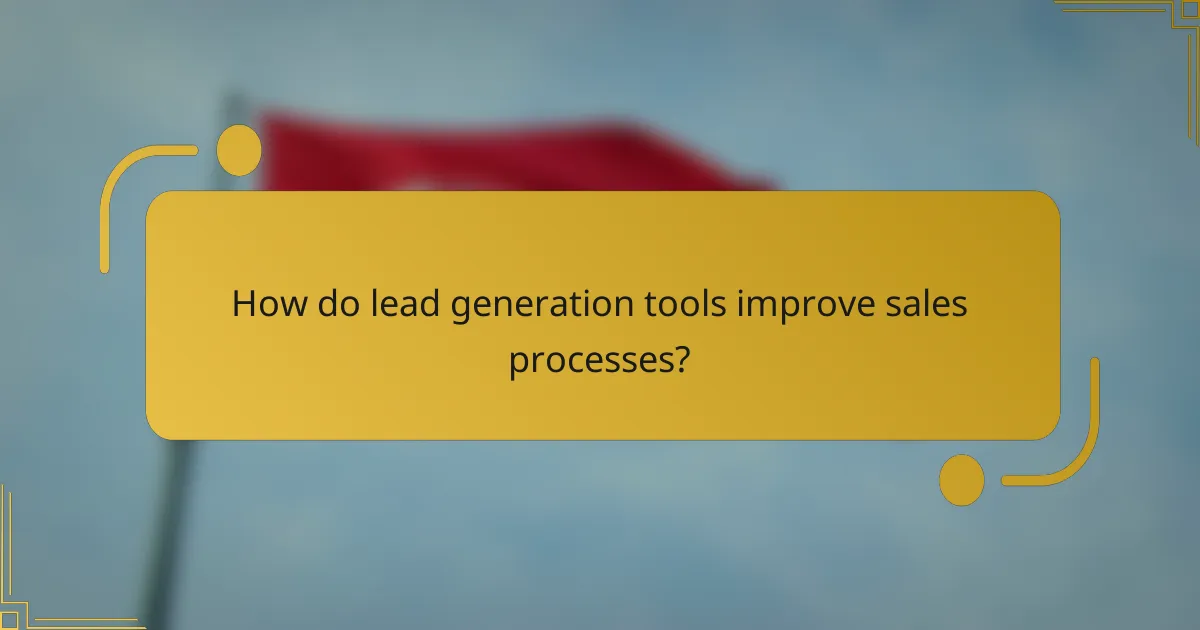Lead generation tools are essential for businesses looking to efficiently identify and nurture potential customers. With a variety of features, pricing options, and usability levels, selecting the right tool is crucial for aligning with your specific business needs and budget. These tools not only automate tasks but also enhance sales processes by providing valuable insights that can significantly boost conversion rates.

What are the best lead generation tools for businesses in the US?
The best lead generation tools for businesses in the US include platforms that streamline the process of identifying and nurturing potential customers. These tools vary in features, pricing, and usability, making it essential to choose one that aligns with your business needs and budget.
HubSpot
HubSpot is a comprehensive inbound marketing platform that offers robust lead generation features. It includes tools for email marketing, landing pages, and CRM integration, allowing businesses to attract, engage, and convert leads effectively.
Pricing for HubSpot varies based on the features you choose, with a free tier available for basic functionalities. Paid plans can range from a few hundred to several thousand dollars per month, depending on the scale and additional tools required.
Salesforce
Salesforce is a leading CRM platform that excels in lead generation through its extensive automation and analytics capabilities. It allows businesses to track customer interactions and manage leads efficiently, providing insights that help in nurturing relationships.
Salesforce pricing can be on the higher side, often starting in the low hundreds per user per month. However, its extensive features and customization options can justify the cost for larger businesses with complex needs.
LinkedIn Sales Navigator
LinkedIn Sales Navigator is a powerful tool for lead generation, particularly for B2B businesses. It enables users to find and connect with potential leads through advanced search filters and personalized recommendations based on user behavior.
The subscription cost for LinkedIn Sales Navigator typically ranges from around $80 to $150 per month, depending on the plan. This investment can yield significant returns by enhancing networking and lead acquisition efforts.
Marketo
Marketo is a marketing automation platform that specializes in lead generation and nurturing. It offers features like email marketing, landing page creation, and lead scoring, helping businesses to engage leads throughout their buying journey.
Marketo’s pricing is generally tailored to the specific needs of the business, often starting in the mid-hundreds per month. Companies should assess their marketing goals to determine if the investment aligns with their lead generation strategy.
ActiveCampaign
ActiveCampaign combines email marketing, automation, and CRM functionalities to facilitate lead generation. Its user-friendly interface and powerful automation tools allow businesses to create targeted campaigns that effectively convert leads into customers.
Pricing for ActiveCampaign is competitive, starting at around $9 per month for basic features and scaling up based on the number of contacts and advanced functionalities. This makes it an attractive option for small to medium-sized businesses looking to enhance their lead generation efforts.

How do lead generation tools improve sales processes?
Lead generation tools enhance sales processes by automating tasks, prioritizing prospects, and providing actionable insights. These tools streamline the identification and nurturing of potential customers, ultimately increasing conversion rates and sales efficiency.
Automated outreach
Automated outreach allows sales teams to engage with leads without manual effort, saving time and resources. Tools can send personalized emails, schedule follow-ups, and manage social media interactions automatically, ensuring consistent communication.
For instance, a tool might automatically send a welcome email to a new lead within minutes of their sign-up, increasing the chances of conversion. This feature is particularly beneficial for businesses with large volumes of leads, as it helps maintain engagement without overwhelming sales staff.
Lead scoring
Lead scoring helps prioritize leads based on their likelihood to convert, allowing sales teams to focus on the most promising prospects. By analyzing various factors such as engagement level, demographics, and behavior, these tools assign scores to leads, guiding sales efforts effectively.
For example, a lead who frequently visits your website and downloads resources may receive a higher score than one who only signed up for a newsletter. Implementing lead scoring can significantly improve conversion rates by directing efforts toward leads that show genuine interest.
Analytics and reporting
Analytics and reporting features provide insights into lead generation performance, helping businesses refine their strategies. These tools track metrics such as conversion rates, engagement levels, and campaign effectiveness, enabling data-driven decision-making.
Regularly reviewing these analytics can reveal trends and areas for improvement. For instance, if a particular outreach campaign shows low engagement, adjustments can be made to messaging or targeting. Utilizing these insights effectively can lead to more successful lead generation efforts and increased sales outcomes.

What features should you look for in lead generation tools?
When selecting lead generation tools, focus on features that enhance your ability to capture, manage, and convert leads effectively. Key functionalities include CRM integration, email marketing capabilities, landing page builders, and social media integration, each contributing to a streamlined lead generation process.
CRM integration
CRM integration is essential for managing leads efficiently. A good lead generation tool should seamlessly connect with popular CRM systems like Salesforce or HubSpot, allowing for automatic data transfer and updates. This integration helps maintain accurate records and facilitates follow-up actions.
Consider tools that offer customizable fields and workflows to match your specific sales processes. This ensures that your team can track leads through the sales funnel effectively, reducing the chances of lost opportunities.
Email marketing capabilities
Email marketing capabilities are crucial for nurturing leads over time. Look for tools that allow you to create targeted email campaigns, automate follow-ups, and segment your audience based on behavior or demographics. This personalization can significantly increase engagement rates.
Additionally, features such as A/B testing and analytics can help you refine your email strategies. Aim for tools that provide insights into open rates, click-through rates, and conversions to optimize your campaigns continuously.
Landing page builders
Landing page builders enable you to create dedicated pages for specific campaigns or offers. A robust lead generation tool should include an intuitive landing page builder that allows for easy customization without needing extensive coding knowledge. This can enhance your ability to capture leads effectively.
Look for features like A/B testing, mobile responsiveness, and integration with analytics tools. These elements help you measure the performance of your landing pages and make necessary adjustments to improve conversion rates.
Social media integration
Social media integration is vital for expanding your reach and capturing leads from various platforms. Choose tools that allow you to connect with social media accounts, enabling you to share content directly and track engagement metrics. This can help you identify potential leads from social interactions.
Consider tools that offer features like social listening and analytics to understand your audience better. This insight can guide your content strategy and improve your overall lead generation efforts by targeting the right demographics on the right platforms.

What are the pricing models for lead generation tools?
Lead generation tools typically utilize various pricing models, each designed to cater to different business needs and budgets. Understanding these models can help businesses choose the right tool based on their lead acquisition strategy and financial considerations.
Subscription-based pricing
Subscription-based pricing involves paying a recurring fee, usually monthly or annually, for access to the lead generation tool. This model often includes different tiers that offer varying features, such as the number of leads generated, access to analytics, and customer support levels.
Businesses should consider their lead volume and required features when selecting a subscription plan. For example, a small business might opt for a basic plan costing around $30 to $100 per month, while larger enterprises may need premium plans that can exceed $500 monthly.
Pay-per-lead pricing
Pay-per-lead pricing charges businesses based on the number of leads they acquire through the tool. This model is beneficial for companies that want to control costs and only pay for the leads they actually receive.
Prices can vary widely depending on the industry and lead quality, typically ranging from a few dollars to several hundred dollars per lead. It’s essential to evaluate the expected conversion rates to ensure that the investment aligns with potential revenue.
Freemium models
Freemium models offer basic features at no cost, allowing users to access the tool without an upfront investment. Users can then pay for additional features or higher lead limits as their needs grow.
This model is ideal for startups or small businesses testing the waters of lead generation. However, users should be cautious of potential limitations in the free version, such as restricted access to advanced analytics or customer support, which may hinder growth.

How to choose the right lead generation tool?
Choosing the right lead generation tool involves assessing your specific business needs, budget, and the features that will best support your marketing strategy. Focus on usability, integration capabilities, and the quality of leads generated to ensure the tool aligns with your goals.
Key features to consider
When selecting a lead generation tool, prioritize features such as CRM integration, automation capabilities, and analytics. A tool that seamlessly integrates with your existing systems can enhance efficiency and data accuracy. Additionally, look for features that allow for segmentation and targeting, which can improve lead quality.
Pricing models and what to expect
Lead generation tools typically offer various pricing models, including subscription-based, pay-per-lead, or tiered pricing based on features. Expect to pay anywhere from a few dozen to several hundred USD per month, depending on the tool’s capabilities and your business size. Always evaluate the return on investment by considering the potential revenue generated from leads.
Usability and support
Usability is crucial when choosing a lead generation tool. Look for intuitive interfaces and comprehensive support resources, such as tutorials and customer service. Tools that offer free trials can help you assess usability before committing financially. Additionally, consider the availability of ongoing support to address any issues that may arise during use.



